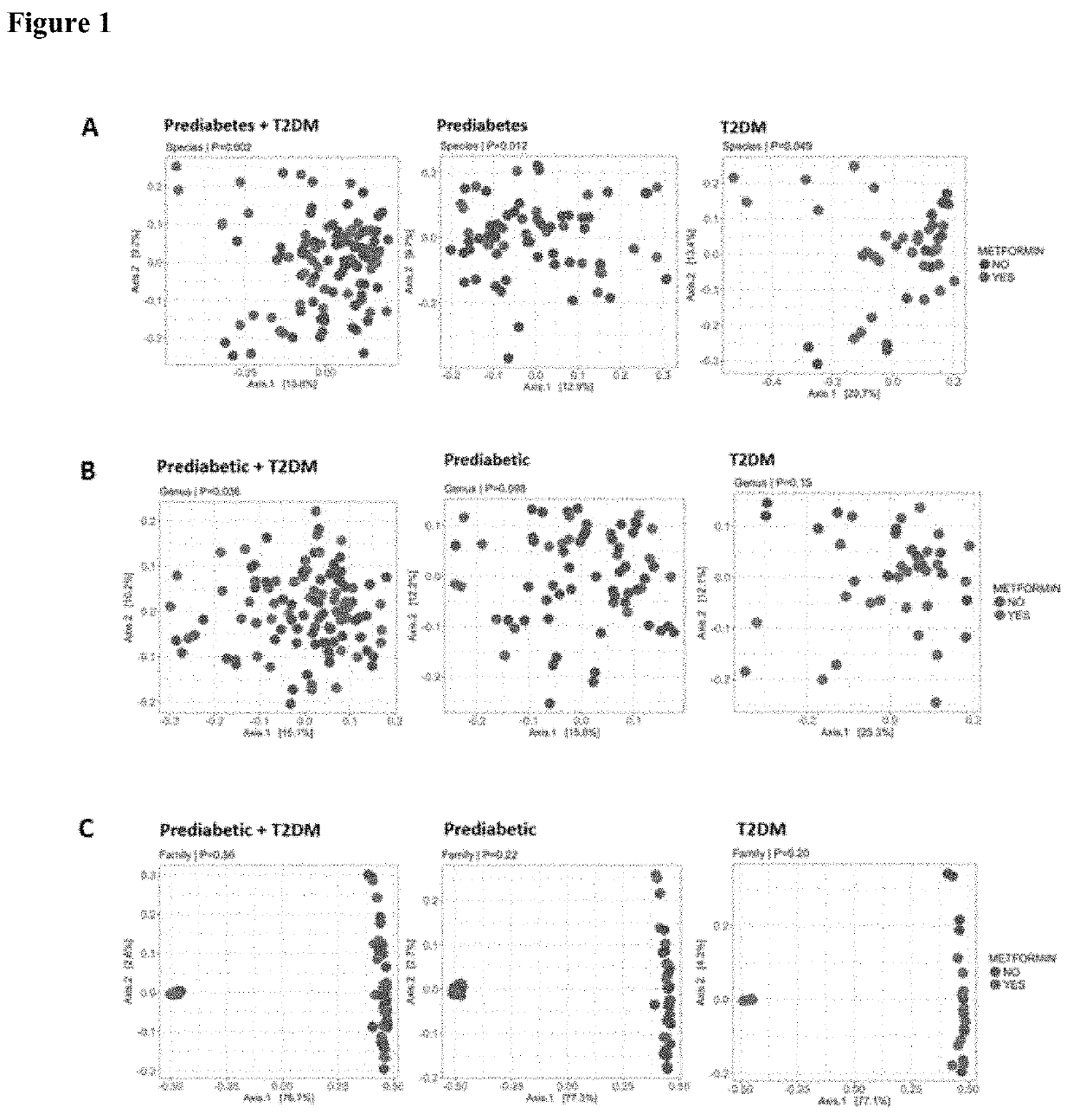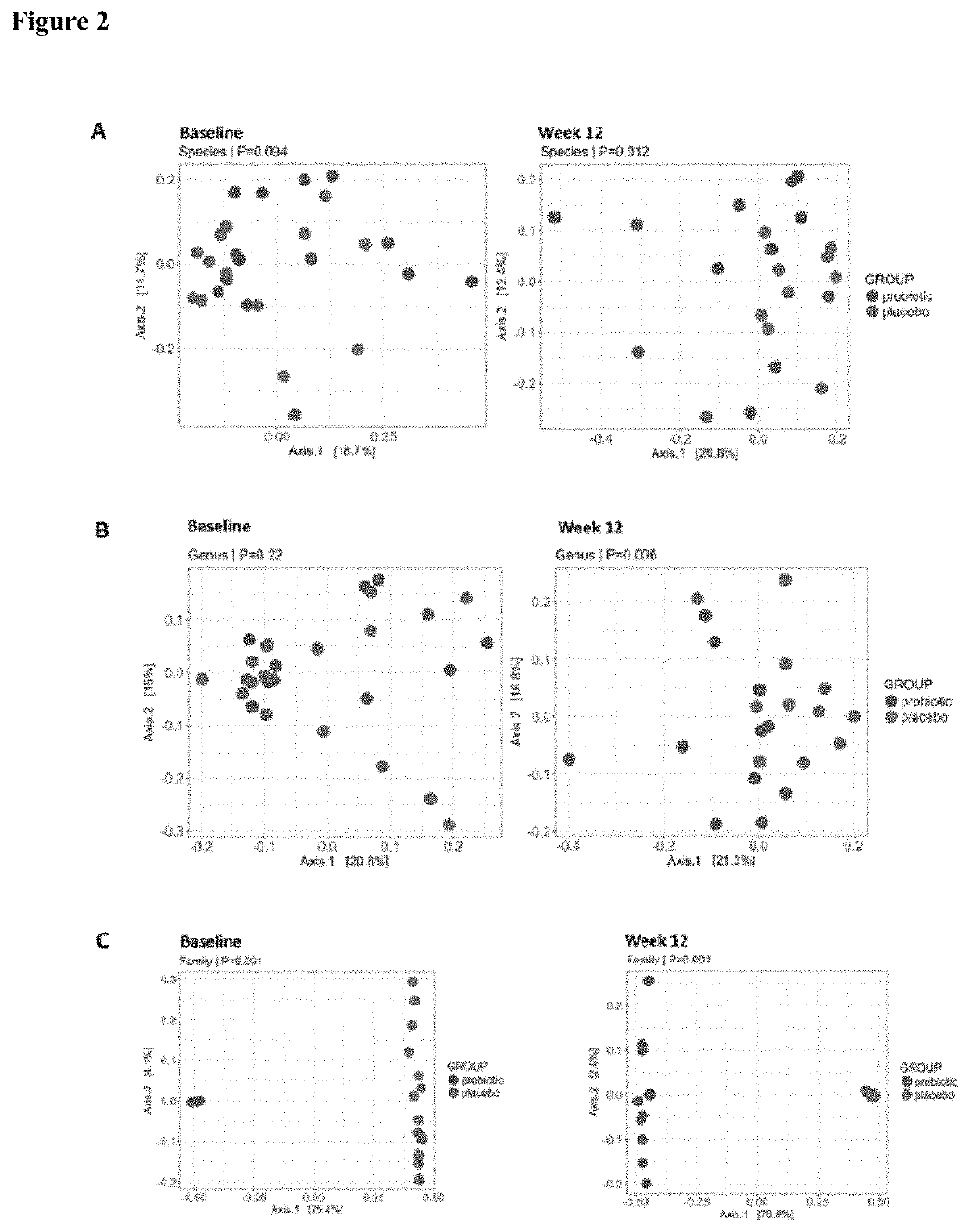Modulation of intestinal microbiota in pre-diabetes and type 2 diabetes
a type 2 diabetes and microbiota technology, applied in the field of pre-diabetes and type 2 diabetes, can solve the problems of adverse side effects and unsatisfactory results for individuals, and achieve the effects of reducing bmi, improving insulin sensitivity, and reducing glycosylated haemoglobin (hba1c)
- Summary
- Abstract
- Description
- Claims
- Application Information
AI Technical Summary
Benefits of technology
Problems solved by technology
Method used
Image
Examples
example 1
ind, Randomised, Placebo-Controlled Trial
Study Protocol
[0077]The study described herein was a pilot, single site, randomised, double blind, placebo-controlled trial. Ethical approval was granted by the Sydney Local Health District Human Research Ethics Committee, RPA Hospital, Sydney, Australia. The study was carried out according to the Declaration of Helsinki, the National Health and Medical Research Council National Statement on Ethical Conduct in Research Involving Humans and the Notes for Guidance on Good Clinical Practice as adopted by the Australian Therapeutic Goods Administration and the International Conference on Harmonisation Good Clinical Practise guidelines. Written informed consent was obtained from participants before enrolment.
[0078]Individuals were eligible for the study if the following criteria were met: (i) aged ≥18 years; (ii) BMI≥25 kg / m2; (iii) pre-diabetes or type 2 diabetes mellitus diagnosed within the previous 12 months (criteria for the diagnosis of pre-...
example 2
Metformin and a Multi-Strain Probiotic Combination on Intestinal Microbiota in Type 2 Diabetic and Pre-Diabetic Subjects
[0091]The baseline intestinal microbial profile of participants, as determined by 16S rRNA genes of microbes in faecal samples showed that 99% of the sequences were distributed among three bacterial phyla the Bacteroidetes, Firmicutes and Proteobacteria. The remaining 1% was composed primarily of Actinobacteria, Verrucomicrobia, Fusobacteria and Tenericutes.
[0092]Operational taxonomic unit (OTU) tables were extracted from Ion Reporter software and the data from MALDI-TOF reports analysed to assess if the abundance of specific microbial species changed after the probiotic intervention. A significant increase was found in the probiotic group compared to the placebo group (pLactobacillus gasseri, Bifidobacterium longum, Bifidobacterium bifidum and Saccharomyces boulardii, in addition to a decrease in the butyrate-producing bacteria Roseburia intestinalis and Roseburia...
example 3
f a Multi-Strain Probiotic Combination on Glycaemic Parameters in Type 2 Diabetic and Pre-Diabetic Subjects
[0095]Subgroup analyses in participants diagnosed with type 2 diabetes showed reductions in HOMA-IR associated with the probiotic intake after adjustment for baseline HOMA-IR, metformin, sex and age (regression coefficient −2.64; 95% CI: −4.58, −0.70; p=0.01). Within group comparisons also revealed that HbA1c levels and insulin sensitivity indices improved in the probiotic group, while in the placebo group no significant changes were found. Changes within the probiotic group were also found in subgroup analyses. In participants with type 2 diabetes in the probiotic group, the mean change of HbA1c and HOMA-IR was −0.7±0.8% (p=0.025) and −2±2.7 (p=0.05), respectively. In contrast, no significant changes were found in participants with type 2 diabetes in the placebo group (HbA1c: −0.4±0.8, p=0.14 and +0.7±2.4, p=0.3).
PUM
| Property | Measurement | Unit |
|---|---|---|
| time | aaaaa | aaaaa |
| time | aaaaa | aaaaa |
| time | aaaaa | aaaaa |
Abstract
Description
Claims
Application Information
 Login to View More
Login to View More - R&D
- Intellectual Property
- Life Sciences
- Materials
- Tech Scout
- Unparalleled Data Quality
- Higher Quality Content
- 60% Fewer Hallucinations
Browse by: Latest US Patents, China's latest patents, Technical Efficacy Thesaurus, Application Domain, Technology Topic, Popular Technical Reports.
© 2025 PatSnap. All rights reserved.Legal|Privacy policy|Modern Slavery Act Transparency Statement|Sitemap|About US| Contact US: help@patsnap.com


